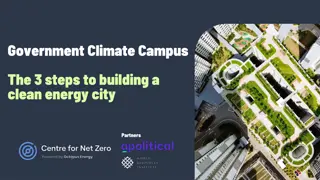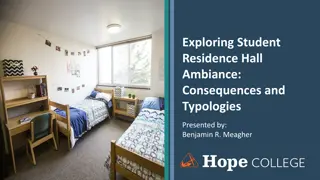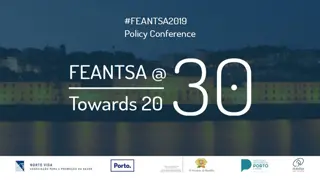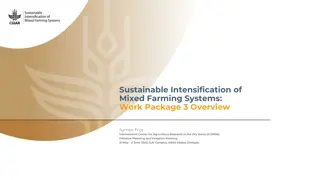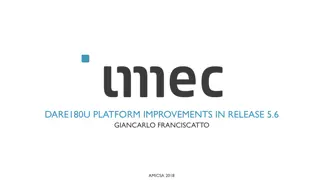
Exploring Interior Design Typologies and Emerging Trends
This article delves into the world of interior design, covering design typologies such as residential, commercial, and traditional interior types. It also introduces emerging building types like bioclimatic buildings and net-zero energy buildings. The discussion includes the classification of different design projects, the importance of typologies in architecture, and the impact of bio-climatic buildings on occupant comfort and energy efficiency.
Download Presentation

Please find below an Image/Link to download the presentation.
The content on the website is provided AS IS for your information and personal use only. It may not be sold, licensed, or shared on other websites without obtaining consent from the author. If you encounter any issues during the download, it is possible that the publisher has removed the file from their server.
You are allowed to download the files provided on this website for personal or commercial use, subject to the condition that they are used lawfully. All files are the property of their respective owners.
The content on the website is provided AS IS for your information and personal use only. It may not be sold, licensed, or shared on other websites without obtaining consent from the author.
E N D
Presentation Transcript
ART 2650 Introduction to Design Process and Programming Fall 2019 M, W 10:00 11:20 Porter Hall 107 Professor: Matthew Ziff Design Typologies (Classification of different types of design projects)
Discipline specific language: typologies In architecture and interior design the term typology is used to describe the kind of space being designed. The type of space or function being addressed. Typology is a way of organizing how we think about spaces and their functions, but it is totally possible, and common, to have mixed typologies existing in one project, in one set of spaces: Think of a restaurant space with an adjoining retail space: a healthcare space with an adjoining pharmacy: an office space with adjoining gym/workout spaces. These are called mixed typologies.
Interior design practice is often split into residential design and commercial design. Residential design is the design of spaces that are the occupants residence. Such places include a variety of built environments: free standing single occupancy houses free standing double occupancy duplex houses row houses of three units or more condominium: a definition of which is: an apartment house, office building, or other multiple-unit complex, the units of which are individually owned, each owner receiving a recordable deed to the individual unit purchased, including the right to sell, mortgage, etc., that unit and sharing in joint ownership of any common grounds, passageways, etc. apartments: living units within a larger building mobile homes
Commercial design is the design of most other types of interiors, including: restaurants shops/stores schools healthcare offices sports facilities government buildings
Traditional Interior Types (typologies) The traditional types of interior design projects are/were: Residential Hospitality Retail Office Institutional Educational
Five Important Emerging Building Types Bioclimatic Buildings Net-Zero Energy Buildings Vertical Farms Resilient Buildings Data Centers
Bio-Climatic Buildings By maintaining a connection to the outdoors and climate zone, bioclimatic buildings enhance occupant comfort with little need for energy-intensive HVAC systems. These buildings are often oriented to leverage daylight and wind patterns, utilize local or site-sourced materials, and incorporate ancient, low-impact construction techniques adapted for modern use. The Tower at PNC Plaza in Pittsburgh. The 33-story tower is passively ventilated through a solar chimney, similar to those found in termite mounds, for nearly half of the year
The Tower at PNC Plaza in Pittsburgh, co-designed by Gensler and Paladino and Co.
Data Centers The desire for ever more computing power drives the demand for these specialized facilities, which are packed with computers, servers, telecommunications systems, backup systems and more. Achieving the elusive sustainable data center is the latest challenge. Everybody s looking at how to handle cooling solutions, be it air- side or water-side economization, he says. Arup designed the Citi Data Center in Frankfurt, Germany, which in 2009 became the first data center to earn LEED Platinum certification.
Net-Zero Energy Buildings All roads in sustainable design are leading to net-zero energy buildings: Title 24 of the California building code mandates that new residential buildings be net-zero energy by 2020 and commercial buildings by 2030, the price of photovoltaic panels has plunged, and concern for the environment is up, says Brad Jacobson, AIA, a senior associate and sustainability leader at EHDD. The San Francisco firm designed one of the nation s first net-zero energy commercial buildings, the IDeAs Z2 Design Facility in San Jose, Calif., in 2007 In this day and age when everyone has this incredibly powerful phone in their pocket that s full of data, it s shocking how little [information] there is about how buildings actually perform.
Vertical Farms At the juncture of architecture and agriculture, indoor urban farms are sprouting up in an increasingly urbanized world that values locally sourced goods. Vertical farms, in which produce grows in multistory racks using lightweight hydroponic or aeroponic systems, are the wave of the future, says Jason Chmura, AIA, an associate at Princeton, N.J. based KSS Architects, which is designing a 69,000-square-foot facility for AeroFarms in Newark, N.J. The efficiency in their design is the small footprint, he says. As [indoor farms] become more popular, the only way they ll work is if they keep going vertical. The lack of available real estate in urban centers means that vertical farms are often also adaptive reuse projects, which adds complexity to their technical design and permitting process. AeroFarms facility, for example, will be housed in a former steel mill.
Resilient Buildings In the face of extreme weather, resilient buildings are designed to maintain functionality or bounce back quickly in the aftermath. Design strategies may be as simple as elevating crucial building systems to avoid floodwaters, or as comprehensive as specifying materials that allow building ground floors to flood, dry out, and return to service, says Robin Guenther, FAIA, a principal of Perkins+Will, which designed the Spaulding Rehabilitation Hospital in Charlestown, Mass. That hospital incorporated lessons learned from Hurricane Katrina, such as the installation of operable, but lockable, windows in patient rooms. Staff threw furniture through windows of sealed buildings following Katrina in order to relieve excessive indoor temperatures, Guenther says. Designing for events that may never happen and that vary by region add to this project type s complexity, she adds. We need to take the science seriously and lead our clients, even when they are skeptical.
Traditional Interiors Typologies Hotel Design Restaurant Design Office Design Retail Design Healthcare Design Residential Design Institutional/Educational Design
Interior Design: ASID Types of Interior Design Design of Work Environments Renzo Piano: Corporate Headquarters of Kum and Go, Des Moines, Iowa

